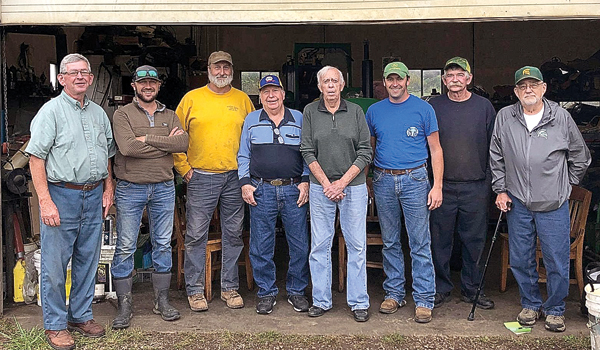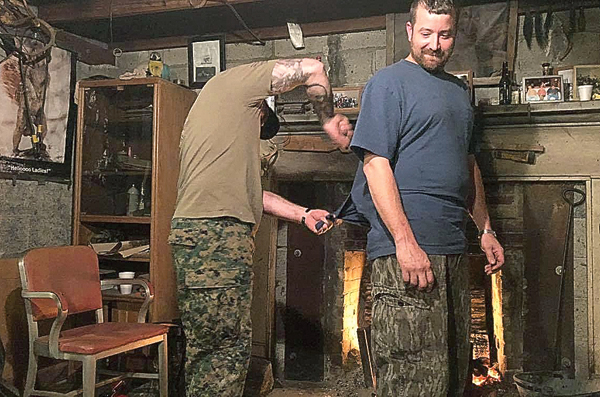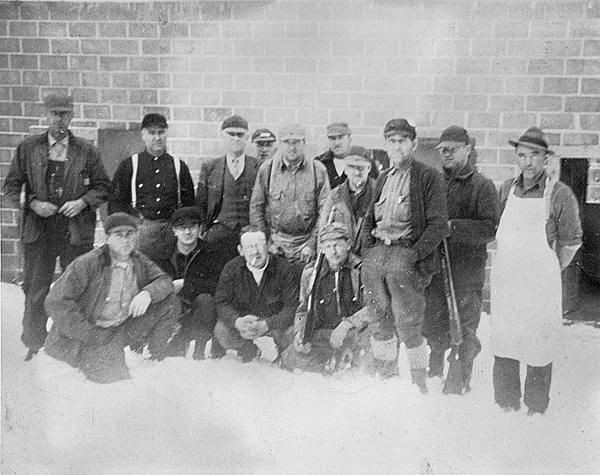

Suzanne Stewart
Staff Writer
In 1940, 11 friends pooled their money and bought a tract of land on which to build a hunting camp near Spice Run on the border of Pocahontas and Greenbrier counties. Dubbed Beaver Lick Hunting Club, the organization is operated by 15 stakeholders who vote in new members when a share is returned to the club.
In the past 80 years, the club has seen several generations of founding families earn their rites of passage into the group, as well as new families join the fold.
Founded by Cecil Stout, Joe Keene, Dave Simmons, Eric Walton, Henry Dunbar, Bill Callison, Harry Keith, Guy Livesay, Ches Lightner, John Bowling and Dick Watts, the club has seen its fair share of good times, great losses and loads of hunting stories that will make you cry from laughing so hard.
In early October, eight members of the club – Jim King, Billy Keane, Terry Brown, Steve Whited, Boyd Brown, Jordan Brown and Hillsboro residents Dustin Simmons and Eugene Simmons gathered at Terry’s garage in Frankford to reminisce and share stories of the good old days at the camp.
The camp went through a few rough years in the 50s when, in 1954 and again in 1958, it was burnt, presumably by an arsonist who was not voted into the club. Although there was never a case to prove the claims, the members believe they know what happened.
“A fellow with a match and a gallon of kerosene,” Billy said, when asked what caused the fires. “In later years, Leon Whited, Steve’s dad, was up on the ridge above the camp and he found an old rusted out kerosene can in a stump up there. That’s the only way it could have got there.
“The story is that the first time it burned, they suspected there was one fellow who wanted to be in – it had to be unanimous to get in this club – and they wouldn’t let him in, and he always carried a grudge,” Billy continued. “Whether he burnt it the second time, that’s up in the air. It’s just a theory he did it the first time. We couldn’t prove it.”
The original building was constructed of cinderblock, but it’s gone through several renovations and additions over the years. It has a full kitchen with dining room, a sitting room and bunks.

One wall of the camp is used to record the history of the camp, with members writing directly on the wall what they deem important for future generations to read.
“I was up there this morning and taking a picture of the wall where Dustin’s grandpa wrote,” Jordan said. “There’s notable things on there, such as ‘Dale Whited used the word exonerated in 1998.’ Something like that.”
“Big words get written down,” Steve added. “They say it, and I know damn good and well they don’t know what it means.”
The camp is used whenever needed, but there are only a few occasions when the entire membership and guests are present.
“We do a big ramp dinner in the spring and the members come up,” Jordan said.
“As far as the notable times we all try to gather there – it’s definitely spring for the ramp dinner and the fall, we have a wood cutting deal – a little bit of wood gets cut, a lot of beer gets drank – in preparation for the hunting season coming up.”
There are some rules at the camp, one of which is women cannot be shareholders and are not allowed to attend camp to hunt. They are, however, allowed to come during special occasions.
Other rules, concerning hunting itself, include – if you miss your shot, you lose your shirt tail – meaning if you shoot at a deer and miss, you have the tail of your shirt cut off and displayed on the Wall of Shame, which is covered in deer spikes.
“If you miss a deer, you’re going to miss a piece of your shirt,” Jordan said.
“They cut your shirt tail off,” Dustin added.
“We almost have enough to make a quilt,” Steve said, laughing.
According to Jordan, a lot of the spikes on the Wall of Shame were Terry’s take in the 1970s. Deer were sparse in the area and when the men were hungry, they didn’t care about the trophy size.
“Starvation is a driving force,” Jordan said. “Terry fed the masses.”
Another rule is if you’re new to the club, you have to go on a specific hunt with Terry. It’s the same hunt Dave Simmons took Terry on when he joined the group and now, in Dave’s memory, he takes the newbies to the same area to hunt.
“There’s a little bit of a rite of passage and respect, which is you have to get up with Terry one day and do the same hunt that Dave took Terry on,” Jordan said. “It’s not the hunting, it’s the education.”
Dustin, Dave’s grandson, got his first and only deer of his hunting history at the camp on that hunt with Terry.
“Terry took me to ‘Sang Run, set me on Jim’s stand, and it was about 7:30 in the morning,” Dustin recalled. “A little spike buck walked in and, of course, I was just sixteen years old and I shot at it and missed it. Terry came up over the hill and sat down there with me.”
Terry and Dustin looked for the spike, but never found it, realizing he missed the shot. Terry gave Dustin some strict, yet encouraging words for his next shot.
“He said, ‘Now son, you realize how far back in here we are,’” Dustin said. “‘You don’t shoot a spike back in here.’ He said, ‘You sit still, you’ll see another one.’ It wasn’t forty-five minutes later, I saw a deer and it was a four point, so I shot and killed it.”
Thinking about the route they had to get back to the camp, Terry made a deal with Dustin.
“He said, ‘I’ll make the same deal with you your granddaddy did with me,’” Dustin said. “He said, ‘I’ll carry the gun and you bring the deer.’ That was about 8:30 in the morning. When we got to the camp, it was getting dark.
“It was the last year my granddad was at the camp, and he got to see me drag the deer in,” he added.
The sentimental stories are just part of the history of the camp, though. There are also the hilarious tales of pranks and tomfoolery that the men recall as if they happened last hunting season.
“Dustin’s granddad, Gene’s dad – you just couldn’t get one over on Dave,” Steve said. “There was an old coon skin cap that stayed there at the camp. When Dave went up, he trapped when he hunted, and he always set dead fall traps. That’s a rock with a stick and the rock falls on it, and blah, blah, blah.
“I don’t know who it was, but someone took that cap, stuck it underneath that rock and tripped it with nothing but it’s tail sticking out,” Steven continued. “Well Dave goes up through there and he goes, ‘I got it,’ and he picked that rock up, pulled the coon skin cap out and he looks back and says, ‘You know you’re a good trapper when you pull a coon out and it’s already made into a hat.’”
The older generation told tales of how there weren’t many deer in the area when they first started going to the camp, so much so, that they would take home any proof they could find that deer actually lived in the area.
“When they started out, there were hardly no deer in Spice Run,” Billy said. “They told a story if you found a pile of deer crap, you brought the little nuggets home with you to prove that you found a deer. They didn’t really start finding deer until they started developing in the fifties and up into the seventies.”
One of the camps many stories was even published in a memoir written by a game warden.
As the story goes, the game warden stopped a truck driven by a then 12-year-old Boyd Brown, who was leaving the camp with a deer in the back of the truck. Someone at the camp had killed a doe and was about to be in trouble with the game warden and his captain.
The two game wardens visited the camp and asked if anyone killed a deer up there. Luckily for the men, someone had left a buck’s head out in the woods, and they were able to pass it off as the one killed by someone at the camp.
“Here sat Dave [cross-legged] with blood on this leg [so he recrossed his legs] and had blood on that leg, too,” Jim said, laughing. “The game warden said, ‘I’ll have to fine everyone here,’ and Dave said, ‘No I killed it, but it wasn’t a doe.’”
The game warden asked Dave to prove it wasn’t a doe, and Dave took him out to where the buck’s head was left.
Many more stories are told by these men, but unlike the ones printed here, those other ones can’t be published. They can only be written on the wall and shared among the members who return to the camp year after year to enjoy the camaraderie and occasional deer hunt.


